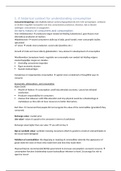1. A historical context for understanding consumption
Consumentengedrag= een multidisciplinair wetenschapsgebied die zich richt op begrijpen, verklaren
en (indien mogelijk) voorspellen van hoe consumenten producten, diensten, tijd en ideeën
verkrijgen, consumeren en weggooien
An early history of consumers and consumption
Voor middeleeuwen produceren eigen voedsel en kleding (subsistence), geen keuzes voor
alternatieve producten of merken.
Middeleeuwen woord consumeren duikt op in latijn, groei handel, meer consumptie (suiker,
specerijen)
17e eeuw steeds meer producten, social code (jewellery etc.)
Growth of trade and more latterly globalization = key element in development of consumption
Weeldewetten (sumptuary laws)= regulatie van consumptie van voedsel tot kleding volgens
maatschappelijke rangen en standen.
Overtollig consumeren beperken
Eigen economie steunen
Standen bekrachtigen
Conspicious or inappropriate consumption against more considered or thoughtful ways to
consume
Economists, philosophers, and consumption
Adam Smith
Wealth of Nations consumption could help stimulate economy. Luxury kon stilstand
voorkomen.
Producers responsibility for consumers
Anxious that labourers with little education and may physical needs be a disadvantage in
marketplace as they did not have resources to better themselves.
Karl Marx Concerned that people did not recognize the value of the commodities (grondstof) they
consumed.
Exchange value= market price
Use value= value of a good to the consumer in terms of usefulness
Exchange value higher than use value you will not buy it
Sign or symbolic value= symbolic meaning consumers attach to goods to construct and participate in
the social world (designer)
Fetishism of commodities= the disguising or masking of commodities whereby the appearance of
goods hides the story of those who made them and how they made them
Maynard Keynes recommended British government to increase consumption: economic recovery
consumption function (relationship tussen besteedbaar inkomen en loon). Encourage the rich to
spend or invest.
,Consumption becomes part of everyday life
First half 19e eeuw grote economische transformatie
Industriele revolutie 18e eeuw meer productie en hogere arbeidsproductiviteit prijzen daalden,
meer mensen kunnen dergelijke producten kopen
Verbeterde distribution, retailing, advertising
The Royal Exchange Shopping Gallery appeared 1568
Types of product sold changed people could bought more than needed
Model changes, update wardrobes, mobile phones, computers etc. long before they no longer work.
Conspicuous (opvallende) consumption
Thorstein Veblen, concerned with the very wealthy and how they consumed and compared
themselves with one another, extravagand and wasteful (status)
Today we are encouraged not to be wasteful.
Key trends in the development of shopping
New ways to shop
Department stores developed costumer became anonymous
Variety of opportunities to shop has changed available through such different channels and every
part of the day is available for shopping
From service to self-service
Encouraging more purchasing
Doing - shopping: definite articles, a necessary task
Going - shopping: open-ended (impulse purchasing)
Increasingly technological advances are helping to innovate how we shop.
Virtual reality for buying online
Pop-up stores: global reccessionary pressures have stimulated the pop-upping phenomemon with
the increased availability of cheap retail space an dlack of capital to invest in longer-term projects.
First pop-up mall Boxpark low-risk retailing (detailhandel)
Kitkat introduce a new product for a limited time create urgency among consumers
Motivational research-from the rational to the emotional
USA car, mass production, investment, wealth creation
Consumers began to have disposable income choose how to spent their money
Sigmund Freud
psychoanalytical research: why consumers did or did not buy their products
peoples behaviour often determined by irrational and unconscious motives and socialized
inhibitions
, Why consumers liked or did not like certain products asking why unlikely to reveal the real
reasons
Hidden Persuaders
The rise of motivational research
Ernst Dichter
Recognition of both the role of emotions in our choice decisions and that these could not always
analysed or explained from a rational viewpoint
How does the consumers receive the personality of the product
Critiques of motivational research (pyschological techniques were being tried out through Dichter)
1. Motivational research not a cure-all for all marketing problems
2. Diagnostic tools from clinical psychiatry applying to consumers: was niet helemaal geldig
3. Motiverend onderzoek te sterk afhankelijk van de intepretatie van de persoon met few
standardized or validating testing procedures
4. The findings of motivational researchers had not been subjected to objective confirmation by
gebruikelijke methods before they were applied to business situations
Although motivational research suffered from the attack of Packard ↑ het wordt hedendaags toch
nog gebruikt om de consument te kunnen begrijpen.
From consumers to consumerism: the politics of consumption
Governments should protect the rights and safety of other consumers (working conditions in
factories bv.)
Consumer rights organizations began to increase. Protected in marketplace dealings.
Responsibility to the consumer not only in producing goods but in ensuring that they are safe, fair
and of the value promised.
Increased activism (oa. Tegen consumeren) consumenten nu veel informatie om betere keuzes te
kunnen maken
Meest significante kwesties is de houdbaarheid van de wereld. Productie en consumptie vernietigen
de planeet klimaat verandering moet getackeld worden.
Classifying consumers
Gabriel and Lang 9 types (describing trends and ways of consuming (or not) rather than types of
people)
Chooser, communicater, explorer, identity-seeker,hedonist/artist, victim, rebel, activist, citizen
Today marketers also interested in identifying wheter such typologies are differten for digital
consumers.
Consumer victims
Lack knowledge, unaware of choices, limited choice (low income)
Disability
Vulnerable





